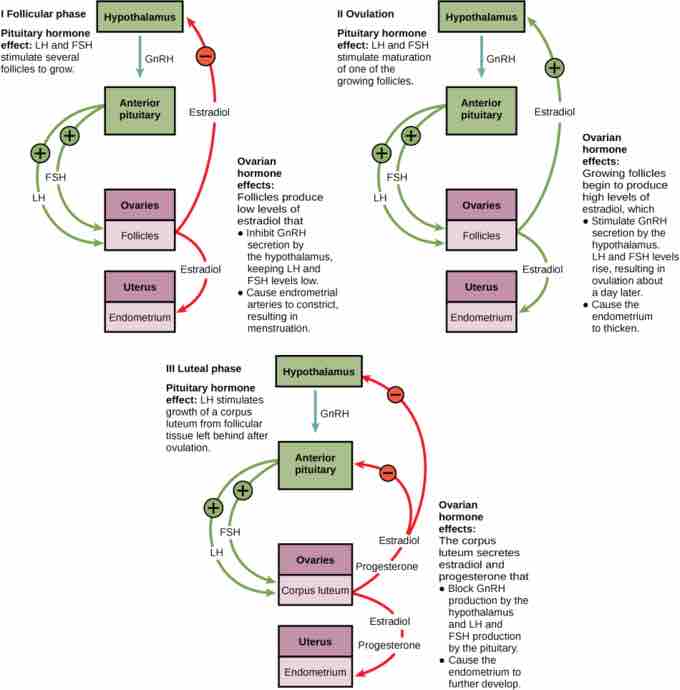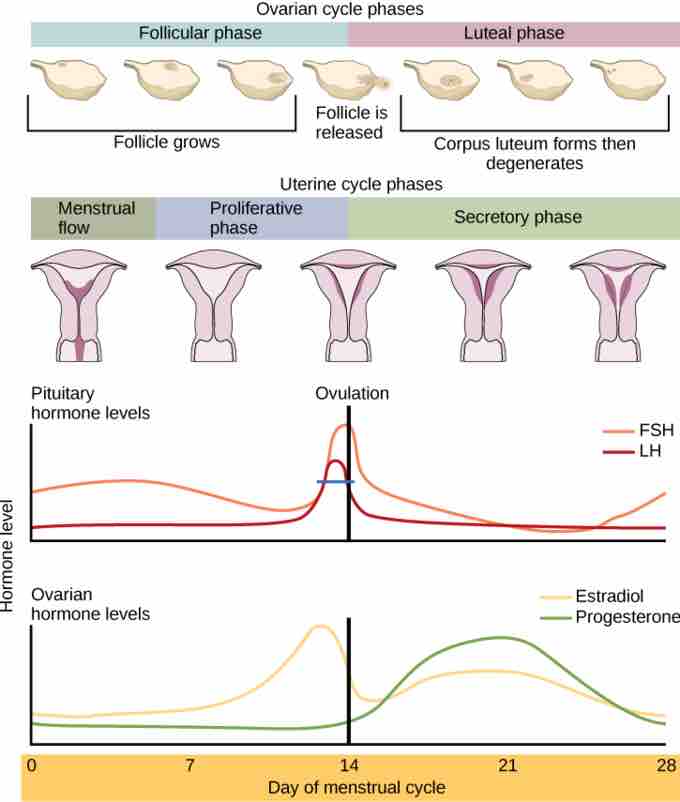Female Hormones
The control of reproduction in females is more complex than that of the male. As with the male, the hypothalamic hormone GnRH (gonadotropin-releasing hormone) causes the release of the hormones FSH (follicle stimulating hormone) and LH (luteinizing hormone) from the anterior pituitary. In addition, estrogens and progesterone are released from the developing follicles, which are structures on the ovaries that contain the maturing eggs.
In females, FSH stimulates the development of egg cells, called ova, which develop in structures called follicles. Follicle cells produce the hormone inhibin, which inhibits FSH production. LH also plays a role in the development of ova, as well as in the induction of ovulation and stimulation of estradiol and progesterone production by the ovaries. Estradiol and progesterone are steroid hormones that prepare the body for pregnancy. Estradiol is the reproductive hormone in females that assists in endometrial regrowth, ovulation, and calcium absorption; it is also responsible for the secondary sexual characteristics of females. These include breast development, flaring of the hips, and a shorter period necessary for bone maturation. Progesterone assists in endometrial re-growth and inhibition of FSH and LH release .

Hormonal control of the female reproductive cycle
The ovarian and menstrual cycles of female reproduction are regulated by hormones produced by the hypothalamus, pituitary, and ovaries. The pattern of activation and inhibition of these hormones varies between phases of the reproductive cycle.
The Ovarian Cycle and the Menstrual Cycle
The ovarian cycle governs the preparation of endocrine tissues and release of eggs, while the menstrual cycle governs the preparation and maintenance of the uterine lining. These cycles occur concurrently and are coordinated over a 22–32 day cycle, with an average length of 28 days.
The first half of the ovarian cycle is the follicular phase. Slowly-rising levels of FSH and LH cause the growth of follicles on the surface of the ovary, which prepares the egg for ovulation. As the follicles grow, they begin releasing estrogens and a low level of progesterone. Progesterone maintains the endometrium, the lining of the uterus, to help ensure pregnancy. Just prior to the middle of the cycle (approximately day 14), the high level of estrogen causes FSH and, especially, LH to rise rapidly and then fall. The spike in LH causes ovulation: the most mature follicle ruptures and releases its egg . The follicles that did not rupture degenerate and their eggs are lost. The level of estrogen decreases when the extra follicles degenerate.
Follicle
This mature egg follicle may rupture and release an egg in response to a surge of LH.
If pregnancy implantation does not occur, the lining of the uterus is sloughed off, a process known as menstruation. After about five days, estrogen levels rise and the menstrual cycle enters the proliferative phase. The endometrium begins to regrow, replacing the blood vessels and glands that deteriorated during the end of the last cycle.
Following ovulation, the ovarian cycle enters its luteal phase and the menstrual cycle enters its secretory phase, both of which run from about day 15 to 28. The luteal and secretory phases refer to changes in the ruptured follicle. The cells in the follicle undergo physical changes, producing a structure called a corpus luteum, which produces estrogen and progesterone. The progesterone facilitates the regrowth of the uterine lining and inhibits the release of further FSH and LH. The uterus is again being prepared to accept a fertilized egg, should it occur during this cycle. The inhibition of FSH and LH prevents any further eggs and follicles from developing. The level of estrogen produced by the corpus luteum increases to a steady level for the next few days.
If no fertilized egg is implanted into the uterus, the corpus luteum degenerates and the levels of estrogen and progesterone decrease. The endometrium begins to degenerate as the progesterone levels drop, initiating the next menstrual cycle. The decrease in progesterone also allows the hypothalamus to send GnRH to the anterior pituitary, releasing FSH and LH to start the cycles again .

Stages of the menstrual cycle
Rising and falling hormone levels result in progression of the ovarian and menstrual cycles.
Menopause
As women approach their mid-40s to mid-50s, their ovaries begin to lose their sensitivity to FSH and LH. Menstrual periods become less frequent and finally cease; this process is known as menopause. There are still eggs and potential follicles on the ovaries, but without the stimulation of FSH and LH, they will not produce a viable egg to be released. The outcome of this is the inability to have children.
Various symptoms are associated with menopause, including hot flashes, heavy sweating, headaches, some hair loss, muscle pain, vaginal dryness, insomnia, depression, weight gain, and mood swings. Estrogen is involved in calcium metabolism and, without it, blood levels of calcium decrease. To replenish the blood, calcium is lost from bone, which may decrease the bone density and lead to osteoporosis. Supplementation of estrogen in the form of hormone replacement therapy (HRT) can prevent bone loss, but the therapy can have negative side effects, such as an increased risk of stroke or heart attack, blood clots, breast cancer, ovarian cancer, endometrial cancer, gall bladder disease, and, possibly, dementia.